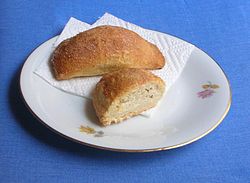Flaó
 Flaons de Morella with a filling of cottage cheese | |
| Type | Pastry |
|---|---|
| Region or state | Catalan-speaking regions, Spain |
| Main ingredients | Cheese, sugar or honey |
| |
Flaó (plural flaons, pronounced [fləˈons]) is a type of pastry made in different locations of the Catalan-speaking regions of Spain, like Morella, Ibiza, Formentera, Menorca and Olot. Traditionally flaons were part of Easter family celebrations in Menorca, but now they are available all-year-round.
The flaons have different shapes, semicircular or circular, and fillings usually based on some type of cheese, varying according to the location. Sweet flaons are usually sweetened with sugar, but traditionally honey was used more often. Historically the first recorded mention of these cakes is from 1252 and they are mentioned as well in Ramon Llull's book Blanquerna, written in 1283.[citation needed] There is a similar pastry in Cyprus known as flaounes.[1]
Contents
1 Variants
1.1 Alt Maestrat
1.2 Ibiza and Formentera
1.3 Menorca
1.4 Matarranya
2 Gallery
3 See also
4 References
5 External links
Variants
Alt Maestrat
In the Alt Maestrat and Ports areas the cake has a semicircular shape and it is filled with a mixture of local cottage cheese (brull) and ground almonds flavored with aiguardent and mistela.[2] The flaons of Morella are the gastronomic icon of the ancient city. An average-sized Morella flaó is about 12 cm long.
Ibiza and Formentera
The flaó d'Eivissa has a circular shape and has a filling of sheep or goat cottage cheese, eggs and sugar, slightly aromatized with peppermint leaves and aniseed.[3] Flaons are usually eaten along with a glass of sweet wine or the local Liqueur frígola, a thyme-based digestive beverage.[4]
Menorca
The flaó de Menorca is a pastry made with tender Maó cheese, wheat flour, olive oil and yeast. Often they include egg and a little lard in the recipe. Good Menorca flaons have to be very puffy in the middle. There are salty and sweet versions of this pastry in Menorca. Some of them have a filling, while in others all the ingredients are mixed together.[5]
Matarranya
The flaonets de Calaceit (Catalan: flaonets = little flaons) are made in Calaceit, a town of La Franja region of Aragon. They are a different kind of pastry despite their name, for instead of cheese these small pastries have a filling based on pumpkin jam and honey.[6]
These flaonets were one of the traditional Spanish pastries fondly remembered by painter Salvador Dalí.[7]
Gallery

Flaó d'Eivissa made in Ibiza

Flaó de Menorca from Menorca
See also
- Flaouna
References
^ Flaounes (Easter Cheese Pastries)
^ Flaons de Morella (in Spanish)
^ Ibiza Food
^ Flaó and Greixonera
^ Rebosteria Típica - Ajuntament de Maó
^ Lluís Gimeno Betí, De lexicografía valenciana, in De las ciencias auxiliares de la Historia a la cultura escrita ed. by Francisco M. Gimeno Blay, 1999, Publicacions de la Universitat de València, .mw-parser-output cite.citation{font-style:inherit}.mw-parser-output .citation q{quotes:"""""""'""'"}.mw-parser-output .citation .cs1-lock-free a{background:url("//upload.wikimedia.org/wikipedia/commons/thumb/6/65/Lock-green.svg/9px-Lock-green.svg.png")no-repeat;background-position:right .1em center}.mw-parser-output .citation .cs1-lock-limited a,.mw-parser-output .citation .cs1-lock-registration a{background:url("//upload.wikimedia.org/wikipedia/commons/thumb/d/d6/Lock-gray-alt-2.svg/9px-Lock-gray-alt-2.svg.png")no-repeat;background-position:right .1em center}.mw-parser-output .citation .cs1-lock-subscription a{background:url("//upload.wikimedia.org/wikipedia/commons/thumb/a/aa/Lock-red-alt-2.svg/9px-Lock-red-alt-2.svg.png")no-repeat;background-position:right .1em center}.mw-parser-output .cs1-subscription,.mw-parser-output .cs1-registration{color:#555}.mw-parser-output .cs1-subscription span,.mw-parser-output .cs1-registration span{border-bottom:1px dotted;cursor:help}.mw-parser-output .cs1-ws-icon a{background:url("//upload.wikimedia.org/wikipedia/commons/thumb/4/4c/Wikisource-logo.svg/12px-Wikisource-logo.svg.png")no-repeat;background-position:right .1em center}.mw-parser-output code.cs1-code{color:inherit;background:inherit;border:inherit;padding:inherit}.mw-parser-output .cs1-hidden-error{display:none;font-size:100%}.mw-parser-output .cs1-visible-error{font-size:100%}.mw-parser-output .cs1-maint{display:none;color:#33aa33;margin-left:0.3em}.mw-parser-output .cs1-subscription,.mw-parser-output .cs1-registration,.mw-parser-output .cs1-format{font-size:95%}.mw-parser-output .cs1-kern-left,.mw-parser-output .cs1-kern-wl-left{padding-left:0.2em}.mw-parser-output .cs1-kern-right,.mw-parser-output .cs1-kern-wl-right{padding-right:0.2em}
ISBN 978-84-370-3931-2
^ Jaume Fàbrega, Dalícies: a taula amb Salvador Dalí, Cossetània Edicions
ISBN 84-9791-001-X
External links
- Gastronomia de Morella
- Balearic Recipes
- Els Flaons - Avui
- My Family's Flaounes

